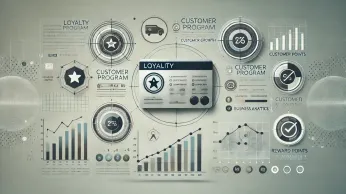On this page
Gone are the days when loyalty programs meant stamp cards and paper vouchers. Digital loyalty schemes have revolutionized how businesses reward and retain customers, offering seamless, tech-driven solutions that fit today’s fast-paced world.
Whether it’s personalized rewards, mobile app integrations, or real-time updates, digital loyalty programs cater to modern customer expectations while simplifying management for businesses.
With the rise of e-commerce and mobile-first consumers, these schemes enable brands to engage with customers across multiple touchpoints, from apps to social media.
In this blog, we’ll explore the benefits, features, and best practices of digital loyalty schemes and how they’re helping businesses build stronger connections and boost long-term growth.
What is a digital loyalty scheme?
A digital loyalty scheme transforms traditional loyalty programs into technologically advanced systems. It leverages digital platforms and data-driven strategies to enhance customer experience and engagement.
Integrating digital technologies like mobile apps, online portals, and data analytics allows businesses to create personalized and convenient loyalty experiences.
Digitization enables businesses to deliver tailored rewards, real-time offers, and interactive features, ultimately strengthening customer loyalty and satisfaction.
📖One prominent example of a digital loyalty scheme is Starbucks Rewards.
Customers can quickly join the program, earn stars for each purchase, and redeem complimentary beverages or food items.
The digital nature of the program allows customers to track their star balance, receive personalized offers and recommendations based on their preferences and location, and conveniently make payments using the app.
Need for digitizing loyalty schemes in today’s digital era
The need to digitize loyalty schemes has become paramount in today’s digital age, where technology and connectivity have become integral parts of consumers’ lives.
Traditional loyalty schemes that rely solely on physical cards or paper-based processes are no longer sufficient to meet the evolving expectations of digitally savvy customers.
Here are vital reasons highlighting the need for digitizing loyalty schemes
1. Changing consumer behavior
Consumer behavior has shifted significantly with the widespread adoption of digital devices and online platforms. Customers expect seamless experiences and personalized interactions.
Digitizing loyalty schemes allows businesses to cater to these changing consumer preferences by providing convenience, real-time rewards, and personalized offers.
Businesses can align their loyalty programs with the preferences and behaviors of their tech-savvy customers.
2. Enhanced convenience and accessibility
Digital loyalty schemes offer unparalleled convenience and accessibility for customers.
With digital platforms such as mobile apps or online portals, customers can easily enroll in loyalty programs, track rewards, and redeem offers anytime, anywhere. The convenience eliminates the need for physical cards or cumbersome processes, enabling customers to engage with loyalty programs effortlessly.
Digitization also allows businesses to provide omnichannel experiences, ensuring consistency and continuity across various touchpoints, further enhancing customer convenience.
3. Personalization and targeted marketing
Digitization enables businesses to gather and analyze customer data to gain insights into individual preferences, behaviors, and purchase history. With this data-driven approach, businesses can deliver highly personalized offers and recommendations to customers, increasing their engagement and satisfaction.
Businesses can foster stronger connections and drive customer loyalty by tailoring rewards based on customer preferences.
Digital loyalty schemes provide a platform for targeted marketing strategies, ensuring that customers receive relevant and valuable incentives, which can significantly impact their overall satisfaction.
4. Real-time engagement and feedback
Digital loyalty schemes enable real-time engagement and feedback from customers. Businesses can interact with customers through digital platforms, gather feedback, and respond promptly to inquiries or concerns. This instant engagement demonstrates attentiveness and enhances the overall customer experience.
Additionally, real-time data and analytics allow businesses to make data-driven decisions and quickly adapt loyalty program offerings to meet customer expectations, fostering a continuous cycle of improvement and innovation.
5. Competitive advantage
Businesses must differentiate and create a unique value proposition in a highly competitive market. Digitization provides a competitive advantage by offering customers a seamless, personalized, technologically advanced loyalty experience.
Businesses can stay ahead of the competition and position themselves as innovative, customer-centric brands.
Digital loyalty schemes can attract new customers, retain existing ones, and drive positive word-of-mouth, further strengthening their market position.
Significance of loyalty schemes in customer retention and satisfaction
Loyalty schemes are pivotal in fostering customer retention and satisfaction for businesses in today’s competitive marketplace. These programs offer the following benefits cultivate a sense of loyalty and connection with customers.
1. Enhancing customer retention
Loyalty schemes incentivize customers to patronize a particular brand or business. They create a sense of exclusivity and make customers feel valued.
📖According to a study, 77% of consumers of a top-performing loyalty program will continue choosing that brand over others.
Businesses can improve customer retention and reduce customer churn by offering rewards and personalized experiences.
2. Increasing the customer lifetime value
Customer lifetime value (CLV) measures the net profit a business can expect from a customer over their lifetime.
Loyalty schemes increase CLV by encouraging customers to make repeat purchases and engage with the brand over an extended period. Through their exclusive benefits and rewards, loyalty schemes motivate customers to stay loyal, thereby maximizing their lifetime value to the business.
3. Driving customer engagement
Engaging customers and fostering a sense of connection is essential for customer satisfaction.
Loyalty schemes provide a platform for businesses to engage with their customers on a deeper level. Businesses can create a meaningful relationship with their customers by offering personalized rewards, tailored recommendations, and interactive experiences.
4. Gathering valuable customer data
Loyalty schemes offer a valuable opportunity for businesses to collect and analyze customer data. Businesses can gain actionable insights to improve their products, services, and overall customer experience.
A data-driven approach allows businesses to personalize offers, provide targeted recommendations, and anticipate customer needs.
📖 A study revealed that companies that leverage advanced customer data for personalization see a 20% increase in revenue.
How digital loyalty schemes enhance customer experience
Loyalty schemes’ digitization has revolutionized how businesses engage with their customers, elevating the customer experience to new heights. Digital loyalty schemes offer a range of enhancements that significantly improve customer satisfaction and overall experience.
Here are key ways in which digitization enhances customer experience within loyalty schemes:
1. Seamless omnichannel experiences
Digital loyalty schemes enable businesses to provide seamless experiences across online platforms, mobile apps, and in-store interactions. Customers can easily access and engage with their loyalty accounts, view rewards, and redeem offers regardless of their chosen channel.
A seamless integration ensures consistency and convenience, allowing customers to engage with the program in a way that suits their preferences.
2. Personalized offers and rewards
One-size-fits-all approaches no longer suffice in today’s customer-centric landscape. Digital loyalty schemes empower businesses to offer personalized offers and rewards based on individual customer preferences, purchase history, and behavior patterns.
Businesses can tailor incentives that resonate with each customer, increasing the likelihood of engagement and satisfaction. Personalization fosters a deeper connection between customers and the brand, leading to heightened loyalty and advocacy.
3. Real-time rewards and instant gratification
Customers no longer need to wait for physical vouchers or accumulate points over an extended period.
Digital programs enable businesses to instantly provide rewards, discounts, or exclusive offers directly to customers’ digital wallets or accounts, creating immediate value and delight. This instant gratification contributes to a positive customer experience and reinforces the perception of fair value.
4. Gamification and interactive elements
Digitization opens doors to incorporating gamification and interactive elements within loyalty schemes. Businesses can enhance the overall customer experience by infusing aspects of fun and engagement.
Gamification features like progress bars, challenges, and badges can motivate customers to participate actively in the loyalty program, increasing their engagement and enjoyment.
5. Enhanced customer service and support
Digital loyalty schemes often come with integrated customer service and support features. Customers can easily access assistance through chatbots, online support channels, or dedicated loyalty program helplines.
The accessibility ensures customers receive prompt and personalized service, resolving any issues or inquiries they may have regarding their loyalty program experience.
Potential challenges in implementing digital loyalty schemes
While digitizing loyalty schemes offers numerous benefits, businesses should be aware of potential challenges that may arise during implementation. Overcoming these challenges is crucial to ensure the successful adoption and execution of digital loyalty schemes.
Here are some common challenges businesses may face:
1. Technological infrastructure
Implementing a digital loyalty scheme requires a robust technological infrastructure to support seamless integration, data management, and real-time interactions. Businesses may encounter challenges in upgrading their existing systems or investing in new technologies to accommodate digitization.
Ensuring the infrastructure’s compatibility, scalability, and security can be complex and may require collaboration with IT teams and external vendors.
2. Data privacy and security
Digital loyalty schemes involve collecting, storing, and analyzing customer data. Protecting customer privacy and ensuring data security is paramount. Compliance with data protection regulations and implementing robust security measures to prevent unauthorized access or data breaches is crucial.
Businesses must establish proper data governance frameworks, educate employees on best practices for data privacy, and communicate transparently with customers regarding data usage and protection.
3. Customer adoption and engagement
Driving customer adoption and engagement in a digital loyalty scheme can be challenging.
Customers may need to adjust to new processes, technologies, or platforms. Clear communication, user-friendly interfaces, and comprehensive onboarding materials are essential to educate and encourage customers to participate in the digital program.
Furthermore, businesses must continuously engage customers through personalized experiences, relevant offers, and timely communication to maintain their interest and active participation.
4. Integration with existing systems
Integrating digital loyalty schemes with existing systems, such as point-of-sale (POS) systems, customer relationship management (CRM) platforms, or inventory management systems, can be complex.
Ensuring seamless data flow and synchronization between systems is crucial for accurately tracking customer transactions, rewards, and redemption. Collaboration between different departments and stakeholders, including IT, marketing, and operations, is essential to ensure smooth integration and minimize disruptions.
5. Change management and employee adoption
Implementing digital loyalty schemes requires change within the organization. Employees must understand the digital program’s benefits, processes, and functionalities to support and promote it effectively.
Comprehensive training, clear guidelines, and ongoing employee support are vital for successful implementation. Change management strategies should be in place to address resistance or reluctance to adapt to new processes and technologies.
6. Customer experience consistency
Maintaining a consistent and seamless customer experience across different channels and touchpoints can be challenging.
Customers expect a unified experience, whether they engage with the loyalty program through a mobile app, website, or in-store interactions.
Ensuring consistent branding, personalized offers, and synchronized data across all channels requires effective coordination and integration between various teams and systems.
Supercharge your digital loyalty schemes with Loopr
We understand the importance of creating seamless, effective loyalty programs and delivering results. With Loopr, you can easily create enticing offers digitally in a self-service mode.
Loopr helps increase turnover by attracting and incentivizing customers with personalized recommendations that align with their preferences.
It also enables you to recruit new buyers by leveraging targeted promotions and rewards to expand your customer base. Furthermore, Loopr empowers you to retain your customers by providing them with valuable and engaging loyalty experiences.
Contact our team of loyalty experts to explore how digital loyalty schemes can benefit your business and help you improve your customer experience.
Key takeaways
Digital loyalty schemes have redefined how businesses connect with their customers, combining personalization, convenience, and technology to deliver exceptional experiences. Here’s what makes them stand out:
- Personalized rewards: Tailor benefits to match customer preferences for a more engaging experience.
- Omnichannel reach: Engage customers seamlessly across apps, websites, and social media platforms.
- Real-time engagement: Use data-driven insights to refine loyalty strategies and stay relevant.
- Simplified management: Leverage digital tools for hassle-free program operation and scalability.
Digital loyalty schemes aren’t just a trend—they’re a necessity in today’s competitive market. By adopting these programs, businesses can build stronger relationships, foster brand advocacy, and achieve long-term growth. It’s time to embrace the digital transformation of loyalty and unlock its full potential for your brand.
FAQ's
1. Why Are Digital Loyalty Schemes Important for Businesses?
They help businesses build stronger customer relationships by offering personalized rewards, improving retention, and fostering brand loyalty. In a digital-first world, these schemes are essential for staying competitive and relevant.
2. Who Can Benefit from Digital Loyalty Programs?
Businesses of all sizes and across industries, from retail to e-commerce and hospitality, can benefit. Customers also gain value through tailored rewards and seamless experiences.
3. Where Are Digital Loyalty Schemes Used?
These programs are implemented across various channels like mobile apps, online stores, physical locations with digital integrations, and social media platforms, ensuring omnichannel engagement.
4. When Should a Business Implement a Digital Loyalty Scheme?
A business should consider implementing a digital loyalty program when looking to enhance customer engagement, improve retention, or compete in a tech-driven market.
5. How Do Digital Loyalty Schemes Work?
Customers engage with the program by signing up online or through an app. They earn points or rewards for purchases or activities, which can be redeemed digitally for discounts, products, or exclusive perks.
6. What Makes Digital Loyalty Schemes Different from Traditional Programs?
Unlike traditional stamp cards or physical vouchers, digital loyalty schemes leverage technology for real-time tracking, personalized rewards, and seamless integration across multiple platforms, offering a more engaging and efficient experience.








